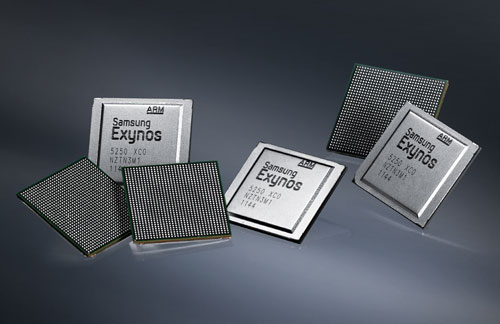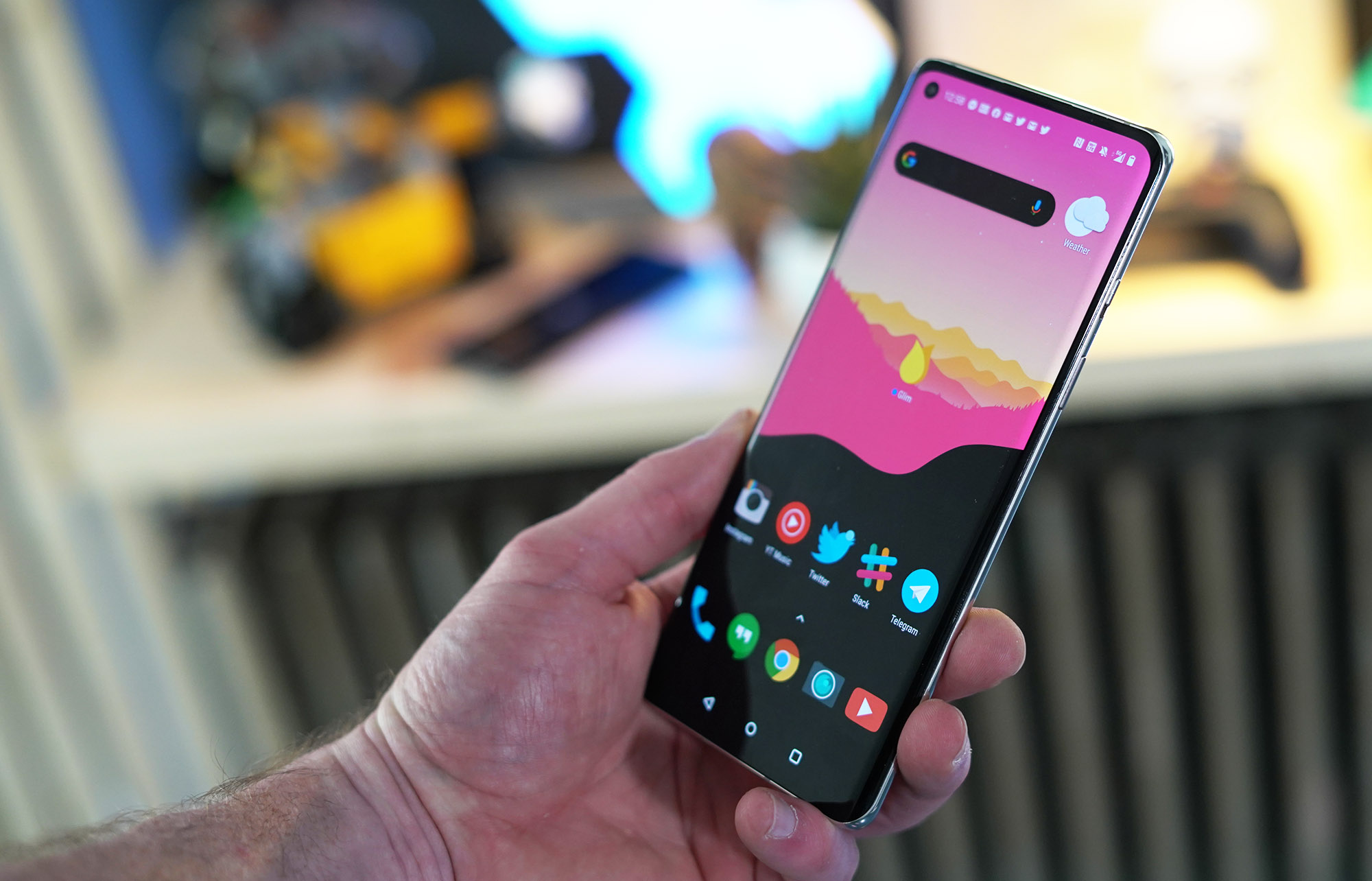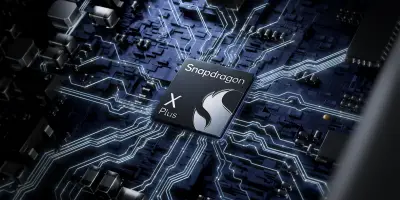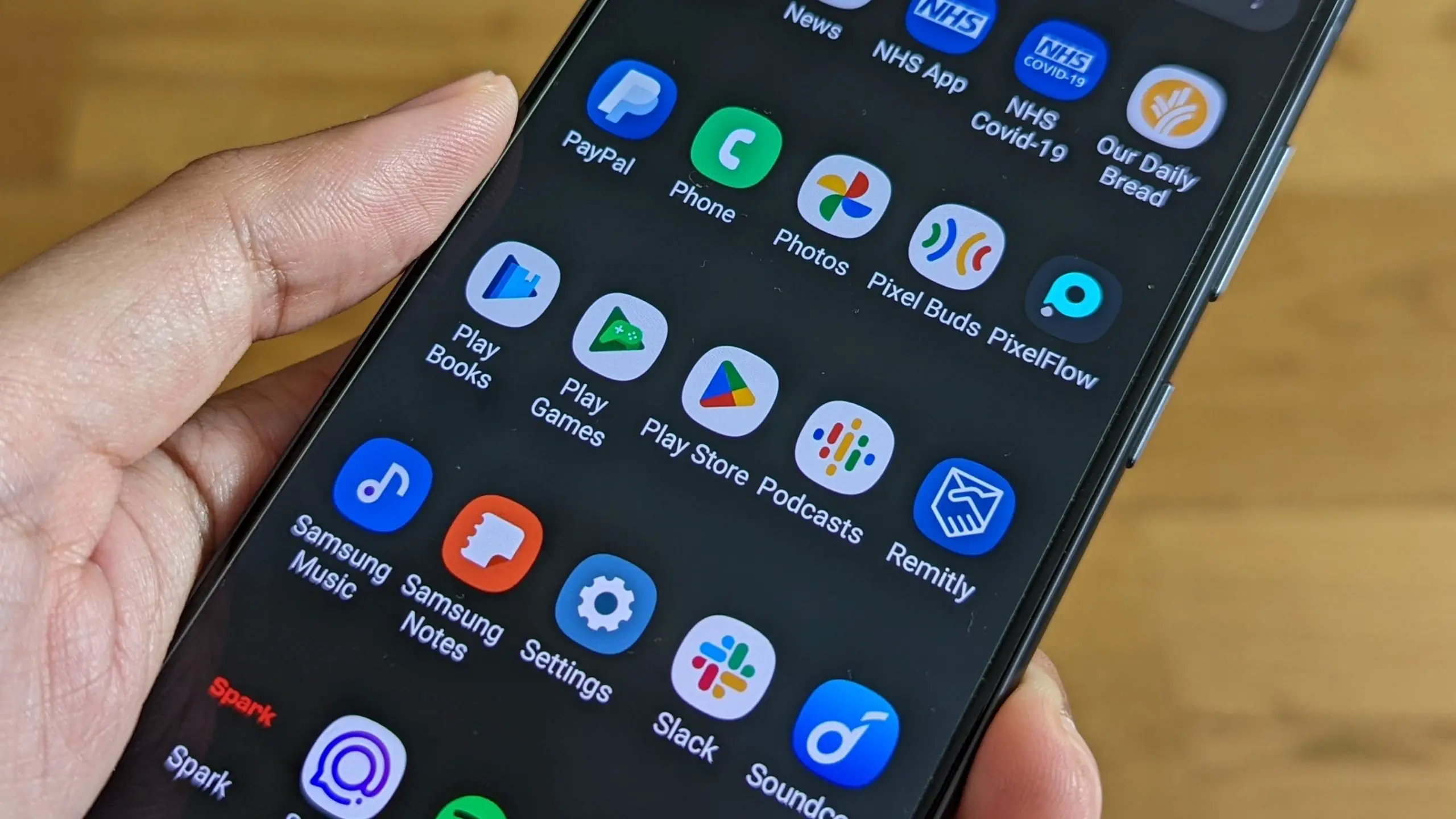Well, what do we have here? Those sexy, silver chiclets you’re looking at are Samsung’s all new Exynos 5250 system-on-chip mobile processors that will be powering your next-next generation Android device. The Exynos 5250 is a 2GHz, Cortex-A15 dual-core processor that could run circles around last year’s 1.5GHz Cortex-A9 dual-core Exynos.
The new 5250 was built using a lower 32nm process that uses less power but provides for better processing performance capable of supporting 3D displays and resolutions up to WQXGADDAJV — roughly translating to 2560×1600. We’re gonna need a bigger screen.
You can look forward to these new chips next year where Samsung says they’ll be mass produced and inside their new high-end tablets during the 2nd quarter. Galaxy Tab 10.1 Plus anyone?
[Via SammyHub]











WQXGADDAJV?
i had to google it :P i think its a joke…..
A bad one at that =/
You almost got me, for a moment i thought a new standard of resolution was being released…..
It’s actually WQXGA resolution.
2560×1600
damn!
Me Luving SAMSUNG more and more, Just look at these Sexy Monster Phones called GALAXY and look at these SEXY Quality TV Series Called D6000-8000, C6000-C8000. i Mean they are really going to own the World
Dual core eh. I have a feeling this will still out perform the A9 quad cores (Tegra 3). Also, lol at Qualcomm who will just then be releasing there A9 dual cores (S4) around this time.
S4 is not Cortex A9. It’s custom design, about 30% faster than Cortex A9, but about 10% slower than Cortex A15.
I feel as though Samsung is a little behind the power curve in the idea that Nvidia has the Tegra3 coming out and Qualcomm’s quad-core snapdragon. Both with the ability to push 2.5 GHz and have the possibility of being placed in phones in the second quarter of next year. I am pretty sure that HTC has already made plans on releasing a phone with the snapdragon three in it.
Quad-core mean nothing if the other two aren’t being utilized. That being said, power cores are more essential than more cores. AMD has the bulldozer series out (8 core processors) but the Intel 2600k (4 core processor) out performs it by a great gap.
True words
I agree quad-core means nothing unless they are being utilized. However, in the near future say the next ten years cell phones and tablets will replace a lot of tools we use as a standard today. With technology evolving as fast as it is I would expect to see client computers in a network changed to tablets in the next five years. Furthermore, with NFC technology I see that controlling much of our life in the future. The things that cellphones and tablets will be able to do will be ridiculous. From a security standpoint I home it doesn’t come to that however, thinking as an American, I feel as though it will come to that because of the convenience. Quad-core may not be 100% necessary right now, however, as phones and tablets begin to take the place of PC’s with the exception of servers and gaming PC’s they will begin to play a more vital role.
The main benefit of a “more-cores” design is the increase of power efficiency. It is not right to take into account only computing power without power consumption.
And your example with the comparison of AMD vs Intel x86 CPU’s is not good there, cos they are using very different architecture and microarchitecture, while every ARM chip (Qualcomm, NVIDIA, TI and others) are using the same microarchitectures of THE Cores (cortex-A**).
If my English was not so bad, i could describe you all the factors (TDP vs freq. and supply voltage curves, for example), that are making quad-core designs more effective than two-core.
BTW, it is strange, that NVIDIA quad-core Tegra 3 is made on the old tech (reserving the space for future chips?) process 40nm. If it was made on 28nm, then…….it is hard for me to find words… :)
sorry, for my English
I guess power efficiency does play a big role…
But about the cpu thing, I’ll give another example then. At the time of Intel’s Q6600 quad core cpu launch, they’re E8600 (dual core) which uses the same architecture, socket, and motherboards as the q6600 out performed their q6600 in any and all games/ applications because their e8600 was able to clock at 4.5Ghz while their Q6600 (quad core) maxed out at around 3.4Ghz. People would think the quad would still out perform the dual core but games and applications at the times only utilized 2 core. Maybe a year or so after the quad core launch of android phones, all four cores maybe utilized, but for now I’ll keep a safe bet on dual core.
Yes, you mentioned one VERY important thing: multi-core optimization of the operating system and applications.
In your example with Q6600 vs E8600 was playing the biggest role exactly that thing. Mainly, of course.
Android OS is based on Linux kernel – it means native multi-core support. And new applications are developing with a good support of multi-core. So, quad (or eight and more) cores will be used more effective, than it was on Windows with Q6600. Just try to remember the time when the first dual-core desktop processor was thrown to the market. ;) OS and bad optimization of apps were making first 2-core processor not so effective, than it could really be.
And of course, not only the number of cores does matter. Implementation – the key. Coherency in the system with many cores and many other things.
Just read this, for example:
http://www.nvidia.com/content/PDF/tegra_white_papers/Variable-SMP-A-Multi-Core-CPU-Architecture-for-Low-Power-and-High-Performance_v1.1.pdf
http://arm.com/files/downloads/big_LITTLE_Final_Final.pdf
Those, who know Russian better than English, try my translations (above documents and more) on my small website dedicated to Android Tablets ;) :
http://androidtabs.ru/preimushhestva-ispolzovaniya-chetyrehyadernyh-processorov-v-mobilnyh-ustrojstvah.html
your english is great, well done.
The space is based on the next ramp up in the roadmap – take tegra 3 and reduce it’s nm then up the clock and reduce the power = next tegra.
Then probably 8 cores on 32nm or 12 on 28nm.
Thank you for your words about my really bad English. :)
Yes, more cores will be. Maybe in 2013 we will see 8-cores design and 20nm technological process. And here starts the Era of laptops using ARM SoCs instead of much less energy effective x86 architecture. Performance per Watt – ARM wins without any chances for x86.
x86 is dead.
o/
Actually Qualcomm alone in the list does not use the Cortex Cores designed by ARM. Both Snapdragon/Scorpion as well as future Krait designs are Qualcomm’s own implementation of ARM V7/V8 ISA.
Loosely Qualcomm is like AMD designing chips that are software compatible with the x86 ISA but having its own chip design and architecture compared to Intel .
Oh, yes, sure you are right – Qualcomm is the only one player, having different from Cortex ARM architecture.
My apologizes for that mistake.
I have no interest in a quad-core for my phone. A dual-core like this should be more than enough to handle anything Android can throw at it until 2013 =p
Except for a small change from Cortex A9 to A15.
Don’t forget about Exynos 4412 if you are interested in Quad Core.
Not to forget Exynos manufactured by 32nm process vs 40nm for Tegra version.
you know what would be cool? interchangeable SoC’s in cell phones. like replacing that old (6 month) A9 with a A15 at home. do they make the same socket’s for these chips?
I know nothing about chips unless they’re potato but I’m positive the answer to your questions is no
They don’t use sockets. They’re soldered directly onto the circuit board with tiny solder balls. Plus, different SoC’s have different pinouts depending on what functions they support, so it would be difficult to have a socket that would be compatible with all of them.
Samsung all the way
F u haters
Hummingbird -> Exynos -> Exynos II
Sure its not quad core, but has samsung and the galaxy family ever failed to out perform the competition? Samsung may have decided to stick with dual core but I’m sure they did it for a reason. We keep adding cores but keep them relatively close when it comes to clock speeds, up the power and efficiency of the current cores and you can still dominate. Plus samsung will have a monstrous gpu to go along with this new chip, I’m sure of that.
do you know whats the most powerful processor ever made and it’s a very OLD one , it’s your brain but we have to figure out a way to connect it with your gadgets
Nvidia: 1ghz quad core. Samsung: 2ghz dual core Qualacom (Can’t spell! ) : 2.5ghz quad core, sounds like 2012 and early 2013 are going to be exciting ! :D
Tegra 3 is 1.3 Ghz quad core Cortex A9. But yes 2013 should be very interesting with quad core 2.5 ghz Cortex A15 chips coupled with Cortex A7 in big.Little configuration.
Im loving my first gen exynos processor!
32nm? Was canceled ! Its 28nm
Galaxy S III anyone?
if they start production in Q2 they will either have to delay the SGS3 or put an other chip in it.
This is the shizzle. F*** nvidia and all their hype. No power
I used to be a specaholic but then I started using the Nexus.
While I’m well impressed with how far the Exynos brand has come, especially in such a short time…Dual-core is really the “now” technology with Quad-core being the “right-around-the-corner” or sooner.
Extending the current dual-core line I could see would be good for upcoming mid-range offerings…But in my mind right now NVidias’ Tegra-3, with its’ Quad-core has the lock as what people want and expect to see in high-end gear.
Hopefully this announcement is just Samsung’s routine new offering in a timeline that’s got quad-cores in its’ midst.
Dual-core for med-range technology?
A 2GHz Dual-core processor is 4X faster than GS2.
Dual or Quad, those are just name, 2GHz x2 is enough for a smartphone right now.
More like 2-2.5x faster than GS2 chip.
NOt when you consider the difference between a9 and a15 on top of the big clock increase. Give hackers a week and Im sure they’ll get the thing up to 2.5ghz too.